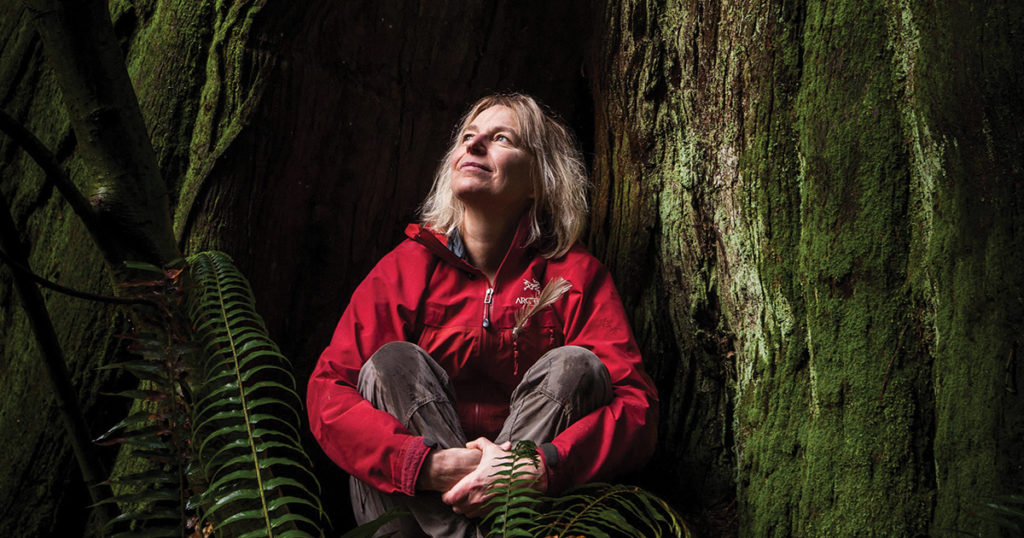
Finding the Mother Tree: Discovering the Wisdom of the Forest by Suzanne Simard; Knopf, 368 pp., $28.95
I took the death of the spruce tree outside our kitchen window personally. When we bought the house a decade ago, it was only as tall as our first story. Now it reached up to the second. But a string of warm, dry springs a few years back fueled an epidemic of spruce aphids—invaders from Europe—that infected our tree, along with scores across our seaside town. It was the only spruce on our property, filling the entire frame of the kitchen window and serving as the occasional perch for a great horned owl. When its needles turned brown and then dropped, I felt a small order of devastation as we gave up hope that the tree would revive. We decided to cut it down.
Many of us look at the trees around us with special affection, even measuring their lives in the context of our own. But there likely isn’t a person in the world whose life is as intricately entwined with trees as Suzanne Simard, an ecologist whose work has transformed our understanding of forests. A researcher at the University of British Columbia’s Department of Forests and Conservation Sciences, she has dedicated her career to unraveling forest mysteries through rigorous experimentation. And beyond her work, all the major events of her life have been tied to trees—from her near drowning at age 12 to her marriage, divorce, illness, and experience of motherhood.
Simard grew up in the 1960s in a British Columbia logging family that went back generations. Amid the region’s inland rainforests, her grandfather and great-uncle felled trees by hand, each man on one end of a crosscut saw. At age 20, Simard was thrilled to land a seasonal job for a logging company in southern British Columbia—the first woman ever hired by the outfit. It was a man’s world: a pinup calendar on the office wall, a paternalistic atmosphere in which no one questioned how things were done. Hiking alone through fog-draped forests of centuries-old trees, Simard would emerge into bright clear-cuts where tree seedlings had been planted in neat rows. Her job was to gauge the health of these tree plantations to ensure maximum wood production.
Many of the seedlings in the plantations were failing, while young trees in the adjacent, uncut woods thrived. Digging into the soil, Simard observed that the roots of healthy seedlings were connected to the soil by a web of fungal strands (in symbiotic relationships called mycorrhizae), whereas the planted trees had no such connections. What Simard saw that summer ignited an irrepressible curiosity to get at the secrets of forests, and a lifetime of research that would challenge conventional forestry practices.
Simard’s work illuminated the critical role of these fungal networks, forming what is known as the “wood-wide web,” with mycorrhizae delivering nutrients, water, and chemical messages between trees, even between trees of different species. But the forestry industry didn’t recognize the enormously important role of these fungi and the connections between trees in the growth and health of forests. Conventional practice following a clear-cut was to douse the denuded acres with Roundup—or burn them—and kill all remaining plants so that well-spaced rows of a single commercially valuable tree species could be planted for the next harvest. Through extensive experiments in the field and in the greenhouse during the decades following that first logging industry job, Simard proved the shortsightedness of these practices.
Simard’s science is beautiful and rife with metaphor. Her work showed that giant old trees nurture young ones, playing an instrumental role in the regeneration of forests. These “mother trees,” which may be connected below ground to hundreds of other trees, provide water and nutrients to young trees, favoring their own young over seedlings from other trees and other species. The nurturing from mother trees makes a seedling four times more likely to survive and helps make the entire forest more resilient in the face of challenges like insect outbreaks and drought. And when these ancient mothers die, they leave behind a wealth of nutrients, like an inheritance.
The stakes are extraordinarily high when it comes to the health of our forests, which are, of course, Earth’s lungs and leaf-bearing air-conditioners. In addition, they help keep rivers and streams running clean and cool and provide critical wildlife habitat. But today, forests are drying out, warming up, migrating, burning, and being devoured by insects. And they’re being razed—a football field every six seconds—to meet our enormous appetite for meat, lumber, paper, and more. A recent study showed that only one percent of British Columbia’s giant old-growth forest area, with ancient mother trees, remains.
As the pages of Simard’s book flew by, with one research question leading to the next and to the next, I couldn’t help but think of all the acres of old-growth forests—all those families of mothers and offspring—being leveled year after year. I wanted Simard to lift her gaze from her experimental plots and academic papers and give us a broader view of the complex economic, political, social, and cultural forces shaping our forests. And I wanted a clearer explanation of how her work changed industry practices, beyond, as she explained, reducing the amount of herbicides sprayed on forest plantations.
Simard’s research has received a lot of attention—TED Talks with millions of views, a cover article in Nature, ample mainstream media coverage—and yet as we know so well after this tumultuous Covid-19 year, science alone is not enough to catalyze societal change. At the start of Finding the Mother Tree, Simard tells us, “This is not a book about how we can save the trees.” Instead, she says, it’s about “how the trees might save us.” And yet, I’m counting on her work to do both.

